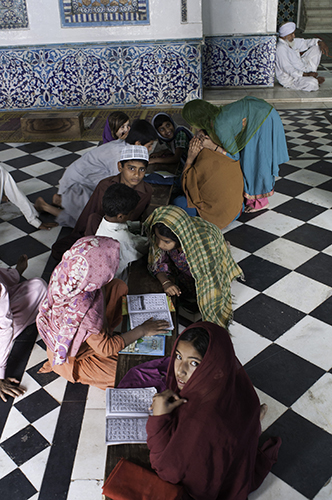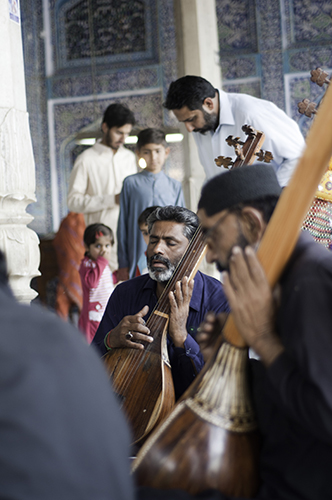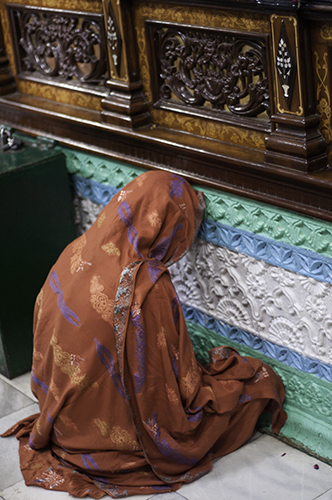Pakistan is also a destination ripe with culture, good food, and a historical legacy of art and literature. In a small town not too far from Hyderabad, one of the oldest cities of the subcontinent, lies the hometown of a great Sufi scholar, mystic, and poet, Abdul Latif Bhittai.
Getting to the town traveling from Hyderabad is simple. It’s just 40 km, or about 25 miles, by car. It’s a sparkling little interfaith city of Hindus, Muslims, and Christians who coexist in their work to preserve culture and way of life.
It’s located in the Matiari District, Sindh, and along the road from Hyderabad and Halaa, you can see a series of large white mounds forming hills. These are known as “Bhit” in Sindhi. The patron poet of Bhit dug a cave into one of these mounds so that he could ponder the deep meaning within himself.

Even as a child, he had a reputation for escaping into these hills to think and be with himself. Later in life, this solitary place allowed him to access his soul and formed the basis for some of his works of mystic poetry.
The town itself is clean and bright. It is known for a cloth called the Arjak, a block printed cloth from the Indus Civilization made through a long process and containing special designs and patterns. It’s a symbol of the Sindhi culture and influence.

Abdul Latif Bhittai
Abdul Latif Bhittai was born around 1690 and raised during the golden age of Sindhi culture. Although he received little formal education, most coming from a local Madrasa, evidence suggests he was well versed in Arabic and Persian, and he kept copies of works from both languages close. He is widely considered the best poet of the Sindhi language.
As a mystic, he denounced unnecessary luxury, injustice, and exploitation in all its forms. His poetry carries a universal theme of love for all beings and the universality of the human race. He praised simplicity and believed that learning happened through our experiences as people.

He married for love, but in a tragic turn of events, his wife died young before bearing any children. He never married again.
He settled permanently in Bhit Shah after traveling and there composed many of his greatest works. Just before his death, he threw his works into the lake. We can read his poetry because, at the behest of one of his disciples, a servant who’d memorized most of his pieces recreated his work.

This compilation was known as “Ganj” and was kept in his mausoleum until about 1854 when it disappeared. Roughly ten years later, German scholar, Ernest Trumpp, recompiled his collection and called it “Risolo” with the help of two other researchers.
The Mausoleum
The Mausoleum was built in the 18th century and attracts around 500,000 visitors annually. It was built in 1772 by then governor, Mian Mustafa Khan Khalhoro. It has been rebuilt and renovated many times from the time of its first construction until now.
The busiest time of the year to visit is during his Urs, or the anniversary of his death. This happens during the Islamic month of Safar. If you want a more spiritual experience, it’s best to visit during one of the off season months so that you have enough peace to take in the beauty of the mausoleum and commune with his legacy.

His final resting place lies under the central dome of the building behind a carved wooden screen under a painted fresco. The building is decorated with intricate tile work and glass in the traditional Sindhi style of blue and white floral patterns.
The entire construction includes this mausoleum and a mosque, and it opens into a court yard surrounded by domed arcades decorated in the same blue and white floral themes.

Visitors frequently find themselves serenaded by the courtyard musicians and can linger and listen to the music dedicated to Sindhi culture and the poet himself. The shrine is well maintained and spacious, with bright sunlight gleaming on the tile.

If you plan to spend any time in the subcontinent, the mausoleum and the small city of Bhit Shah is a don’t-miss destination. Few places hold such links to the cultural past of the subcontinent where you can get away from the bustling metropolises and spend some quality time peacefully observing.

The beauty of Abdul Latif Bhittai’s poetry is mirrored in the landscape of the city, and in the mausoleum dedicated to his memory. Take the time to head just a little out of the way and find a place of ancient poetry to fill your soul. A place you will enjoy spending time in meditation and deep reflection.




